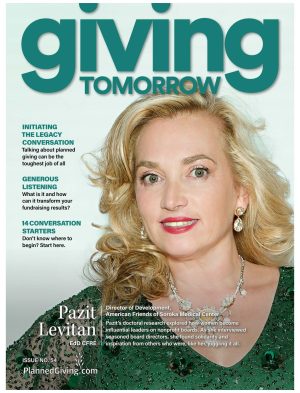What is a Donor-Advised Fund?
A donor-advised fund (DAF) combines investing and charitable giving. This popular giving vehicle can support long-term philanthropic legacy and planned giving goals. Each donor within the DAF has an individual account, allowing for individualized management of the account balances.
First a donor makes a tax-deductible donation to a DAF-sponsoring organization. Sponsoring organizations commonly include community foundations, 501(c)(3) nonprofits attached to financial institutions, and mission-based charities within a specific industry like education or the environment. DAF sponsors also define the kinds of charities they will support for grants from their fund, ranging from virtually any IRS-approved nonprofit to a narrow focus of charities and charitable purposes for their grant gifts.
How Does a DAF Work?
DAF owners make donations in cash or via various approved assets. Depending on the sponsoring organization chosen, a minimum gift to establish a DAF may range from $100 to more than $100,000.
The funds donated to the DAF are irrevocable and destined for charitable purposes only. The donor will receive an acknowledgement from the DAF for the tax-deductible contribution into the DAF account. The sponsoring organization owns and controls the assets of the DAF. However, the donor still makes recommendations (hence “donor advised”) to the sponsoring organization about the investments to be made and the grants to be issued with the money in the account.
Investing the assets within the DAF allows the assets to grow tax-free, generating additional funds in an account for charitable granting. In most cases, you don’t have to make a minimum distribution each year when using a Donor-Advised Fund (DAF), unlike with a charitable gift annuity. This means you can accumulate money, tax-free, before making an even larger donation to charity.
When the donor is ready to recommend a grant to a charity, the sponsoring organization helps facilitate the donation by managing the compliance review of the charity and issuing the grant payment to the nonprofit. Generally, DAF sponsors will support grant requests to most 501(c)(3) nonprofits.
What Can Donors Give to Donor-Advised Funds?
Each sponsoring organization maintains its own guidelines for DAFs. However, donors commonly contribute the following assets to establish a DAF:
- Cash
- Stocks and bonds
- Retirement accounts
- Shares from mutual funds
- Private company stock
- Real estate assets
- Life insurance policies
- Cryptocurrency

What are the Benefits of a Donor-Advised Fund?
As one of the trendiest ways to give a major gift to a nonprofit, donors find many benefits in DAFs.
Taxes
Several different types of tax benefits exist for DAF investors. First, depending upon the donor’s tax situation, donors receive a tax deduction with each contribution into their DAF account. Donors who already give many gifts each year can experience significant tax benefits all at once the year they give to a DAF, instead of the smaller tax benefit of individual gifts over time.
Example: A donor typically gives to multiple charities $1,000 a month or $12,000/year. The $12,000 per year may not qualify for a deduction on their annual tax return, but giving $60,000 to establish a DAF can be applied to their tax returns and rolled over for up to five years. Getting a large deduction in a particular year may be attractive to a donor.
Additionally, donations to a DAF avoid the liability of capital gains taxes and estate taxes.
Simple Estate Planning
Donors can stipulate that the balance of their DAF be transferred to a nonprofit or collection of nonprofits upon their death. This often provides a simplified and seamlessly managed bequest option for planned giving donors.
In addition to transferring assets to charity, DAF donors can choose to transfer the responsibility of managing their DAF to another individual, a family member for instance, continuing their charitable goals for years into the future. This means a DAF can become the first step in establishing a family legacy of philanthropy.
Make Meaningful, Informed Grants
Donors to a DAF often collaborate with community foundations or other sponsoring organizations to invest and make grants with their fund. This means donors receive high-quality information to help them make decisions that can maximize the value of their philanthropy.
Donors become more informed about the needs of their communities by reviewing the eligible nonprofits to which they can make grants.
A Bequest vs. a Donor-Advised Fund
The most notable difference between donating to a DAF vs. leaving a bequest to charity is the loss of control from the donor once the assets are gifted. A bequest can be changed before the distribution of the funds to a charity, while a gift to a DAF is irrevocable.
With a DAF, the donors suggest how their funds are invested and granted. The DAF’s sponsoring organization, while retaining ultimate control over the assets, typically follows the donors’ suggestions most of the time.
However, each sponsoring organization has their own policies and guidelines for investments and grants.
Also, DAF accounts come with fees, which may be a deterrent to some donors. Some sponsoring organizations have annual fee programs based on fund balances, and some charge based on transactional activity.

Conclusion
Donor-advised funds provide a simple way for donors to feel connected to their philanthropic decisions via this investment-slash-planned giving tool. DAF donors enjoy several tax benefits and can learn a lot about the nonprofit community. Some donors may find that DAF policies and fee structures are misaligned with their goals, which may deter them. However, a DAF can offer flexibility and growth opportunities for achieving philanthropic objectives. Donors may find these benefits surpass those of other planned giving tools.
Frequently Asked Quesions
Donor Advised Funds
What happens to a Donor Advised Fund after a donor dies?
A DAF can be configured so that your charitable giving legacy continues after your death. The account can be passed on to family members or friends to advise. It can even be split into multiple DAF accounts that are passed on to your loved ones to advise.
Contact your DAF’s sponsoring organization for specific information on how to pass the account on to a successor(s). The organization will work with your successor(s) before they take responsibility for the DAF. This ensures they are familiar with how the DAF works, as well as your goals for the daf, and can make recommendations accordingly.
Can a Donor Advised Fund be inherited?
Absolutely. As explained in the previous question, you have the ability to name successors who can continue to make recommendations for your DAF after you are gone. In most cases, a DAF can be passed down from generation to generation, making it easy to create and continue a family legacy.
How do I set up a Donor Advised Fund?
To establish a DAF, a donor first needs to contact a sponsoring organization and review its DAF program to determine if it’s the right fit for their giving style. Sponsoring organizations often include individual nonprofits, community foundations, banks, and brokerage services, such as Fidelity Charitable or Schwab Charitable.
The donor or advisor must complete an application and register with the sponsoring organization. Three pieces of information must be established to get started: the DAF’s name; its primary advisor; and the investment allocation preference.
Finally, funds must be contributed to your DAF. That requires completing another form which details contribution amounts and sources. Most DAFs have a minimum contribution amount which varies depending on the sponsoring organization.
Can I name a DAF as a beneficiary?
Yes. You can name a DAF as a beneficiary of your life insurance, charitable remainder trust, annuity, will, retirement plan, or brokerage account. You can also direct a bequest to a DAF through its sponsoring organization.





